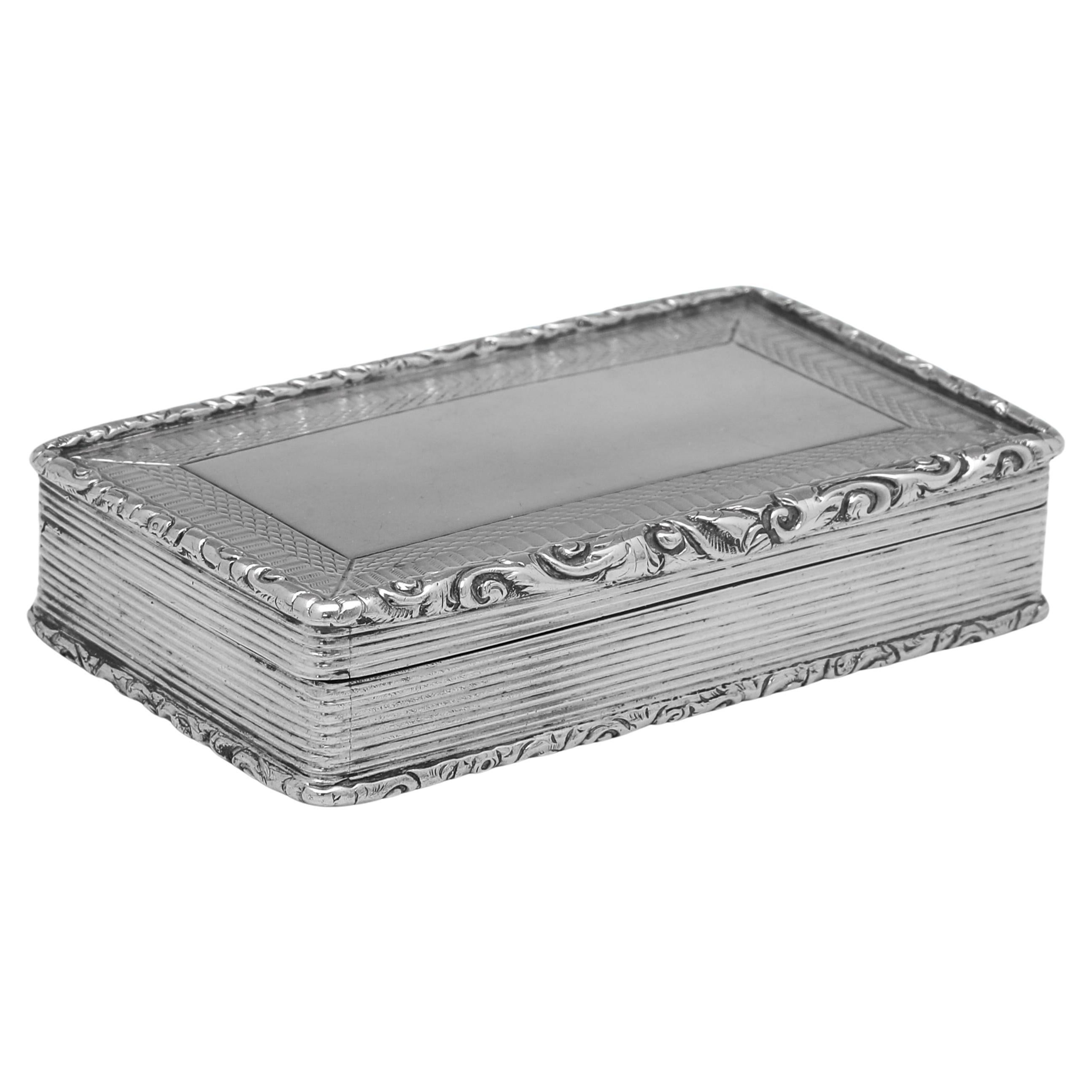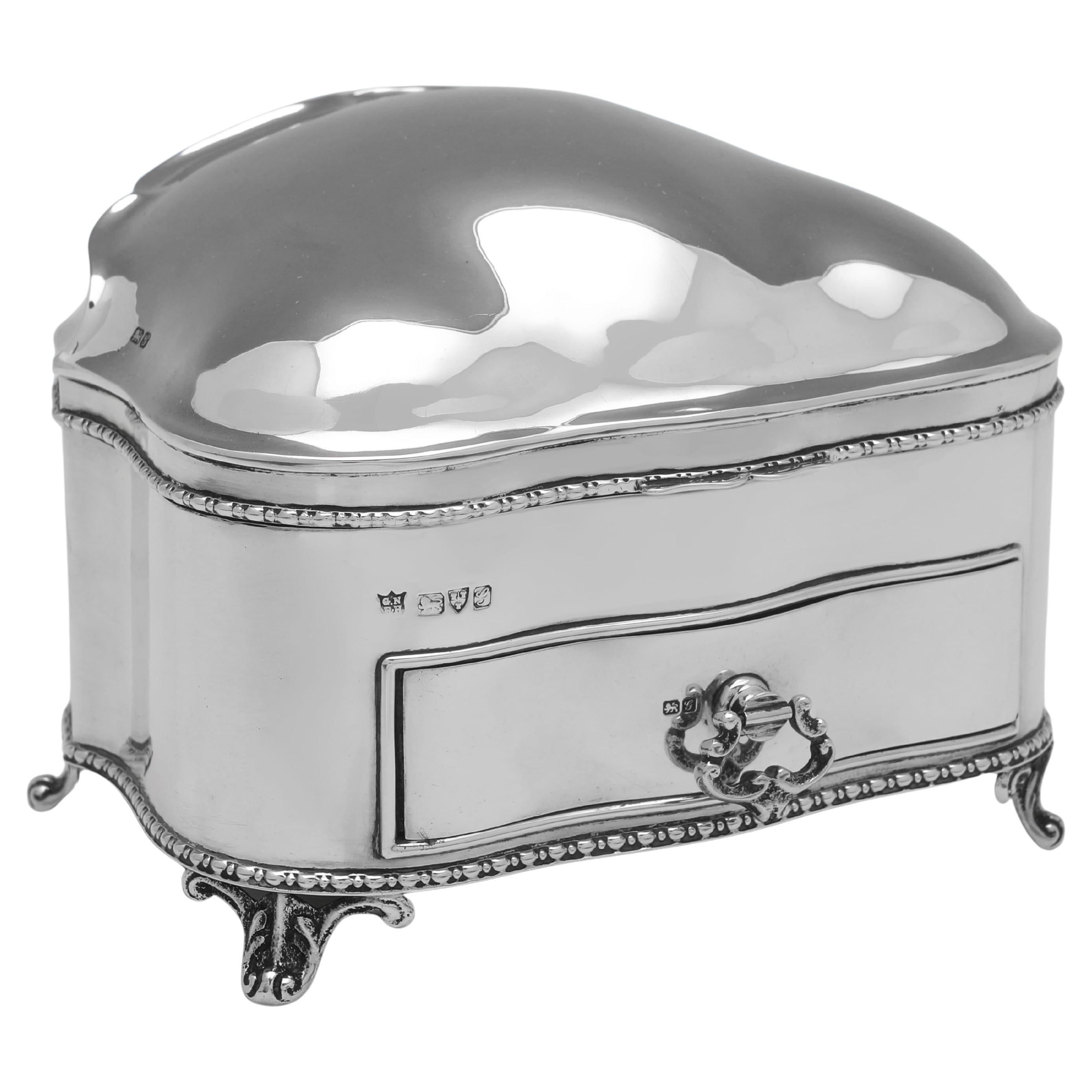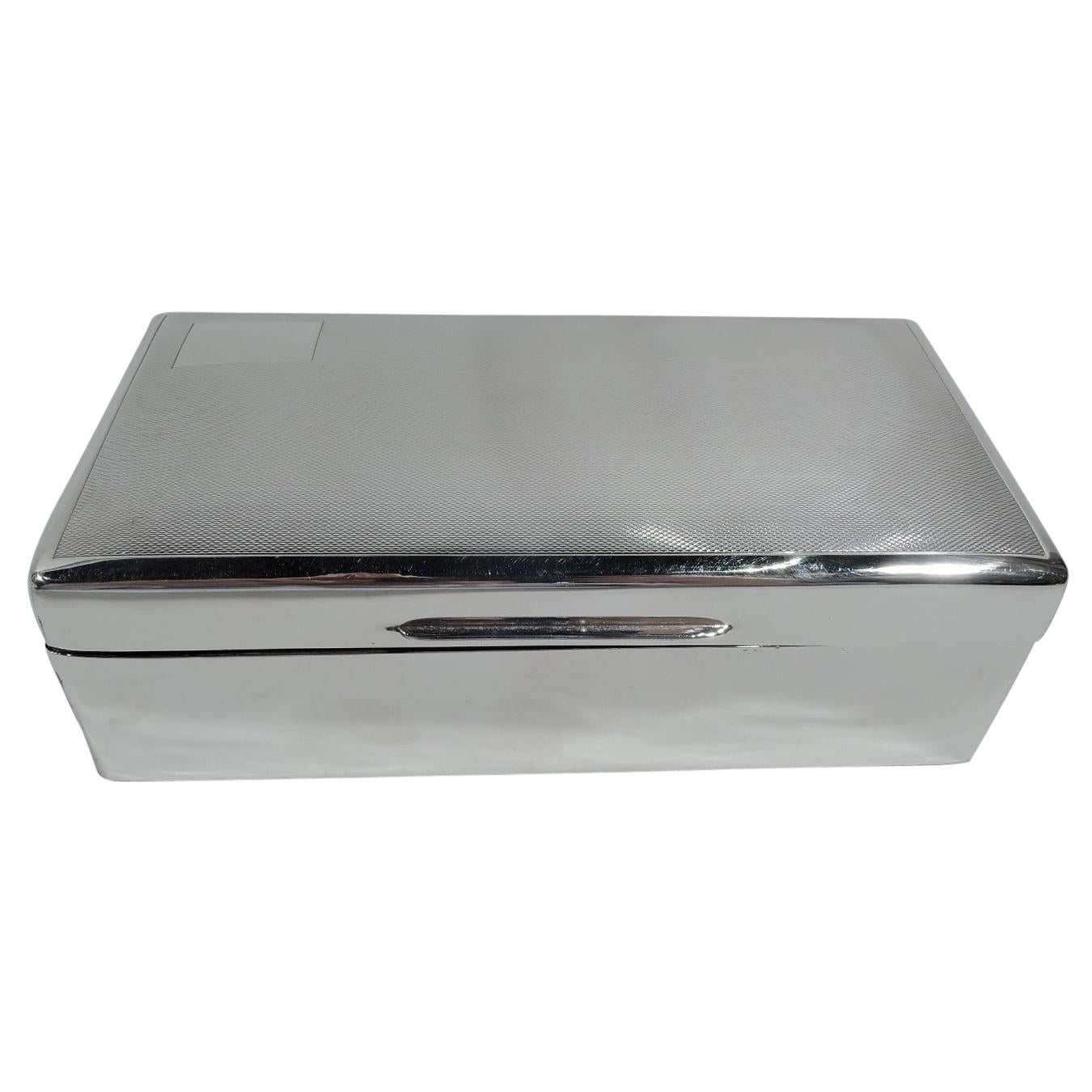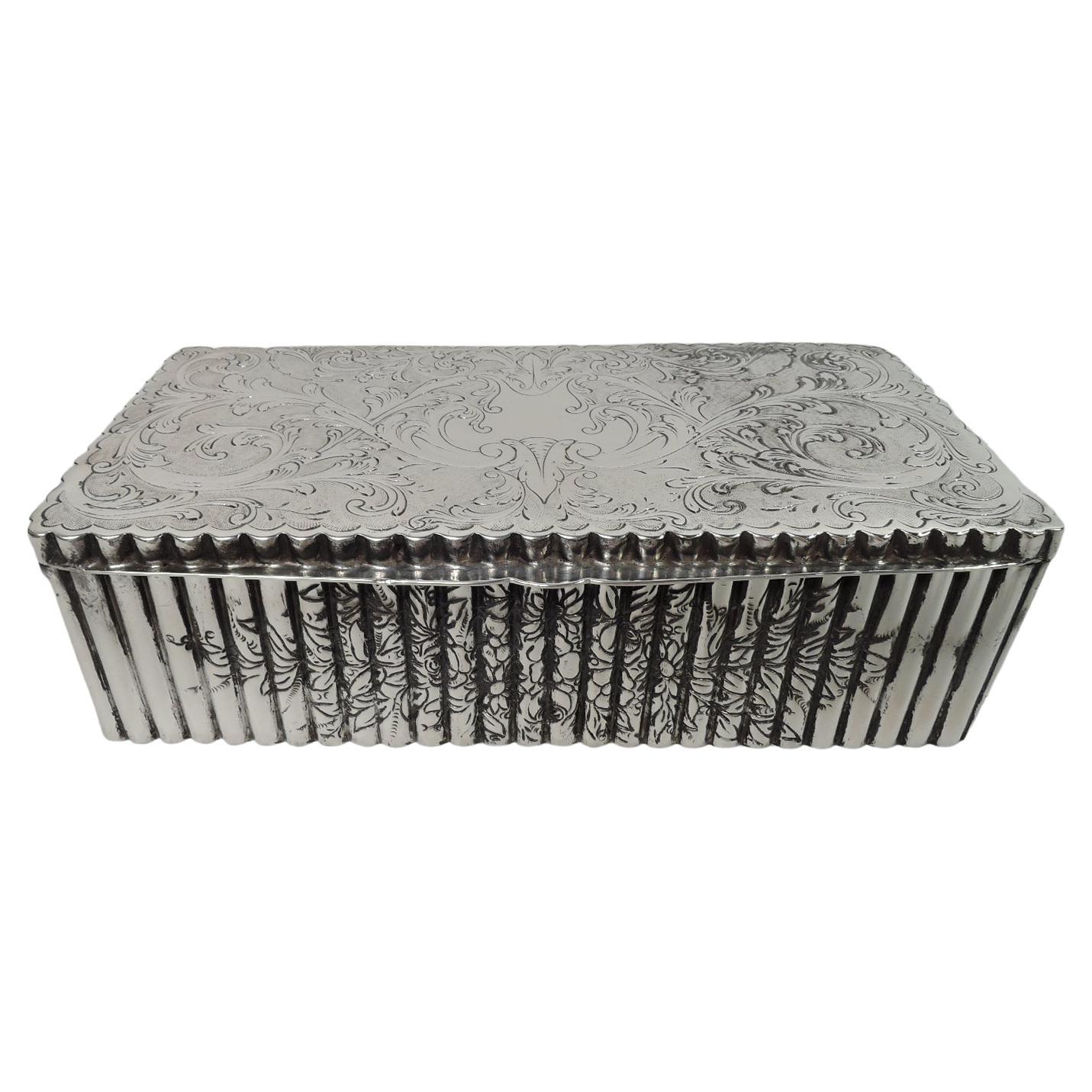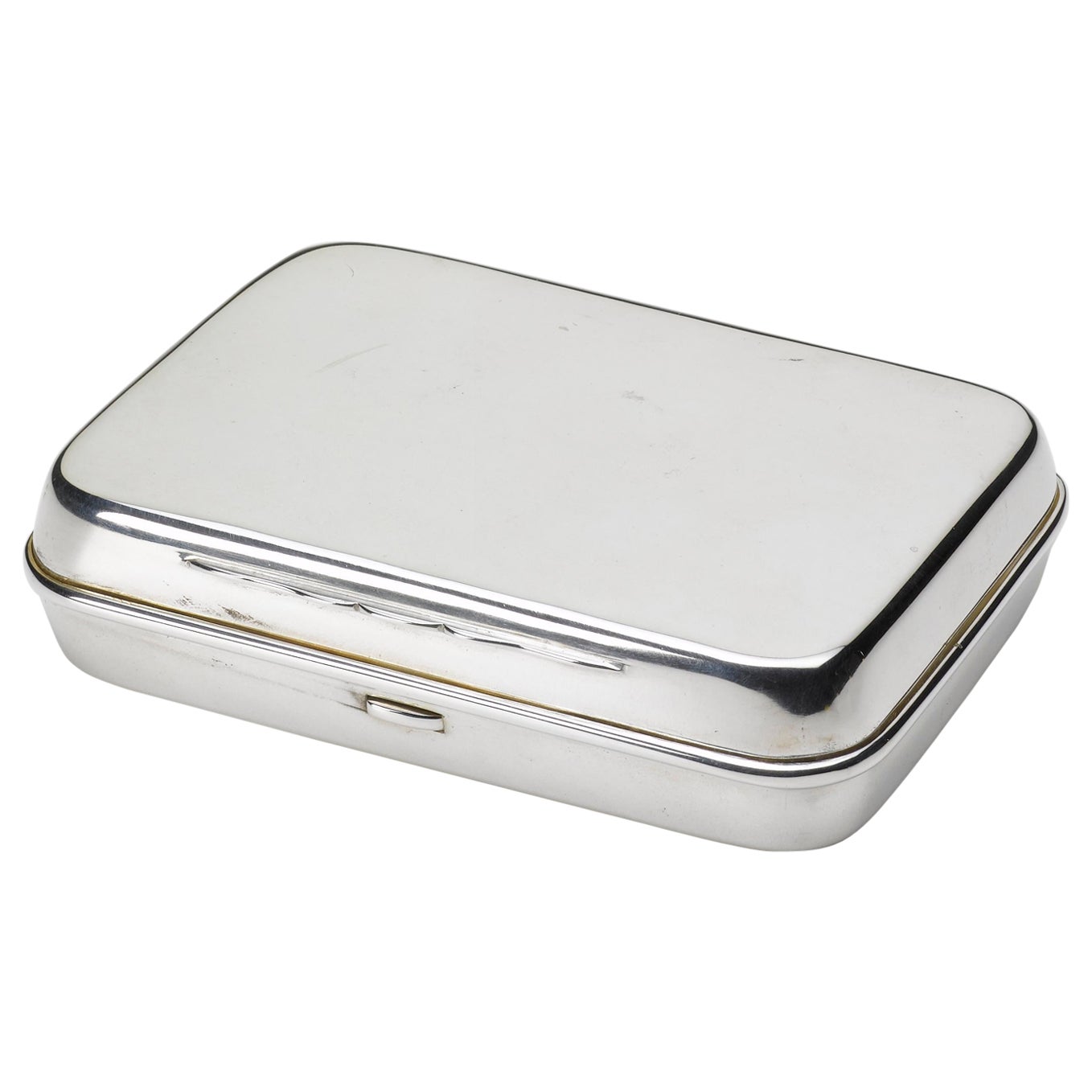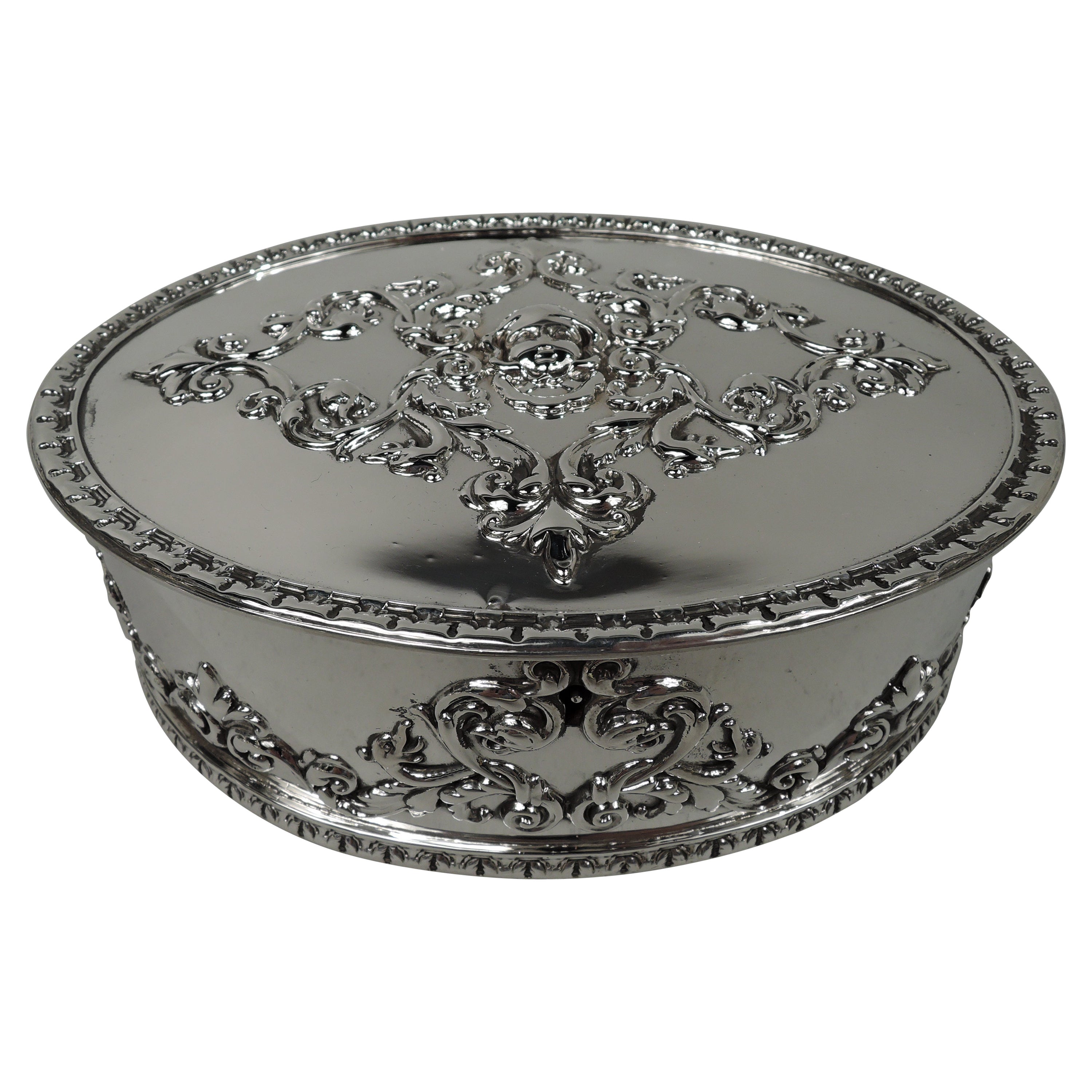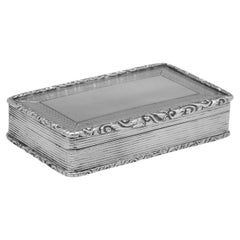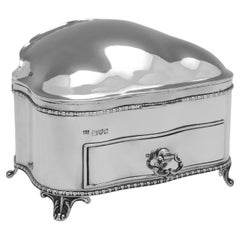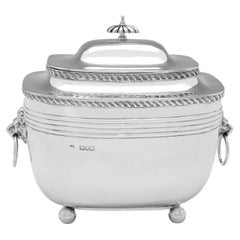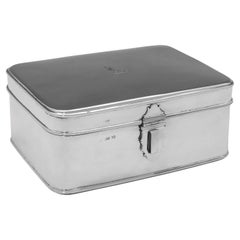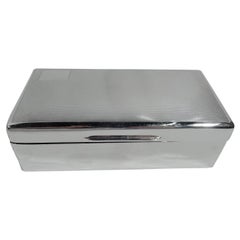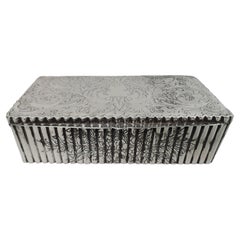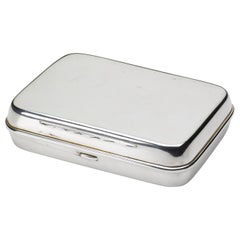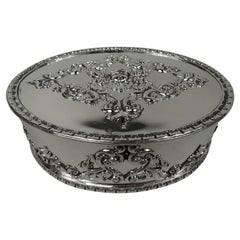Items Similar to Edwardian sterling silver jewellery box made in 1901 by William Hutton & Sons
Want more images or videos?
Request additional images or videos from the seller
1 of 7
Edwardian sterling silver jewellery box made in 1901 by William Hutton & Sons
$3,051.07
£2,195
€2,587.08
CA$4,147.85
A$4,646.13
CHF 2,415.47
MX$57,370.36
NOK 30,771.20
SEK 29,089.39
DKK 19,306.17
Shipping
Retrieving quote...The 1stDibs Promise:
Authenticity Guarantee,
Money-Back Guarantee,
24-Hour Cancellation
About the Item
Hallmarked in Birmingham in 1901 by William Hutton & Sons Ltd., this charming, Antique Sterling Silver Box, is ornate in design, with chased detailing throughout.
The box measures 3"(7.5cm) tall, by 10.75"(27.5cm) wide, by 4.5"(11.5cm) deep, and weighs 19.6 troy ounces.
- Creator:William Hutton & Sons (Metalworker)
- Dimensions:Height: 3.15 in (8 cm)Width: 11.03 in (28 cm)Depth: 4.73 in (12 cm)
- Style:Edwardian (Of the Period)
- Materials and Techniques:
- Place of Origin:
- Period:1900-1909
- Date of Manufacture:1901
- Condition:Wear consistent with age and use.
- Seller Location:London, GB
- Reference Number:Seller: L67441stDibs: LU4930241871652
About the Seller
5.0
Recognized Seller
These prestigious sellers are industry leaders and represent the highest echelon for item quality and design.
Platinum Seller
Premium sellers with a 4.7+ rating and 24-hour response times
1stDibs seller since 2019
235 sales on 1stDibs
Typical response time: 1 hour
Associations
LAPADA - The Association of Arts & Antiques DealersInternational Confederation of Art and Antique Dealers' Associations
- ShippingRetrieving quote...Shipping from: London, United Kingdom
- Return Policy
Authenticity Guarantee
In the unlikely event there’s an issue with an item’s authenticity, contact us within 1 year for a full refund. DetailsMoney-Back Guarantee
If your item is not as described, is damaged in transit, or does not arrive, contact us within 7 days for a full refund. Details24-Hour Cancellation
You have a 24-hour grace period in which to reconsider your purchase, with no questions asked.Vetted Professional Sellers
Our world-class sellers must adhere to strict standards for service and quality, maintaining the integrity of our listings.Price-Match Guarantee
If you find that a seller listed the same item for a lower price elsewhere, we’ll match it.Trusted Global Delivery
Our best-in-class carrier network provides specialized shipping options worldwide, including custom delivery.More From This Seller
View AllVictorian sterling silver snuff box made in Birmingham in 1843
By Francis Clarke
Located in London, London
Hallmarked in Birmingham in 1843 by Francis Clark, this attractive, Victorian, Antique Sterling Silver Snuff Box, features an ornate border, engine turned decoration and a gilt inter...
Category
Antique 1840s English Victorian Snuff Boxes and Tobacco Boxes
Materials
Sterling Silver
Edwardian sterling silver jewellery box hallmarked in Chester in 1907
By Nathan & Hayes
Located in London, London
Hallmarked in Chester in 1907 by Nathan & Hayes, this handsome, Edwardian, Antique Sterling Silver Jewellery Box, features a hinged lid which is lined and has spaces for six rings, a...
Category
Antique Early 1900s English Edwardian Jewelry Boxes
Materials
Sterling Silver
Victorian Antique Sterling Silver Biscuit Box - London 1898 William Hutton
By William Hutton & Sons
Located in London, London
Hallmarked in London in 1898 by William Hutton & Sons, this handsome, Victorian, Antique Sterling Silver Biscuit Box, stands on four ball feet, and feat...
Category
Antique 1890s English Victorian Sterling Silver
Materials
Sterling Silver
Rare William IV period sterling silver lockable box made in London in 1831
By Charles Reily & George Storer
Located in London, London
Hallmarked in London in 1831 by Charles Reily & George Storer, this very handsome, Antique, William IV period, Sterling Silver Box, is plain in design, with reed borders, and an engr...
Category
Antique 1830s English William IV Decorative Boxes
Materials
Sterling Silver
Art Nouveau Period Silver Jewellery Box made by William Comyns in 1903
By William Comyns
Located in London, London
Hallmarked in London in 1903 by William Comyns, this attractive, Edwardian, Antique Sterling Silver Jewellery Box, is oval in shape, and features cast and applied floral detailed fee...
Category
Antique Early 1900s English Art Nouveau Jewelry Boxes
Materials
Sterling Silver
1904 Sterling Silver Cigar Casket – A Gentleman’s Edwardian Essential
By William Comyns
Located in London, London
This exceptional sterling silver cigar box, hallmarked in London in 1904, is a refined example of Edwardian craftsmanship by the esteemed silversmith William Comyns. Elegantly propor...
Category
Antique Early 1900s English Edwardian Cigar Boxes and Humidors
Materials
Sterling Silver
You May Also Like
Antique English Art Deco Sterling Silver Box
By Robert Pringle & Sons
Located in New York, NY
George VI sterling silver box. Made by Robert Pringle & Sons in London in 1939. Rectangular with curved corners. Cover hinged and tabbed; top has engine-turned wave ornament and rect...
Category
Vintage 1930s English Art Deco Sterling Silver
Materials
Sterling Silver
Pretty Antique European Classical Silver Keepsake Box
Located in New York, NY
Pretty European Classical 800 silver keepsake box, ca 1940. Rectangular. Cover flat and hinged with tapering tab. Sides fluted and engraved with fl...
Category
Early 20th Century European Edwardian Sterling Silver
Materials
Silver
Hallmarked Silver Plated Keepsake Box, Sheffield, Uk, Circa 1900
Located in Colorado Springs, CO
Offered is a stunning Sheffield silver keepsake box dating to 1900, with associated hallmark. This small box includes a clean interior and rounded corners. The box is free of names or initials, but would have been used to house keepsakes such as jewelry or cufflinks. A well maintained, elegant piece, this antique silver box is an excellent addition to any silver collection.
Trinket or keepsake boxes have taken on many forms since their first conception in ancient times. However their purpose remains the same; to store jewelry and other items precious to the owner. Originally, these boxes were used specifically for jewelry. These were in common use as early as 5000 BC in Ancient Egypt, when the majority of Egyptians, both male and female, wore jewelry. Boxes were used to keep these gemstone encrusted items safe. In Ancient Rome, jewelry was a status symbol. Rings and brooches were utilized to represent ones status in society. Again, boxes were needed for security and storage purposes. Finding early examples of these are quite rare.
Victorian and Edwardian examples of trinket boxes are far more common. This is because owning jewellery was a luxury until the Victorian era- let alone possessing so much a box was needed to store it all. Fine jewelry and other items became available to the masses after the industrial revolution due to the reduction in production costs. This led to a demand for trinket boxes, which were much smaller than jewelry boxes and therefore better suited to the needs of the middle class who did not yet possess an abundance of jewelry.
In Victorian households, collectables and other items of interested were also stashed inside these boxes. This is why they are known as trinket or keepsake boxes, rather than just jewelry boxes, although of course jewelry was also stored in them. Trinket boxes were produced in large numbers around this time. Many were lined with colored plush or velvet or rich wood. More elaborate designs had interior divisions and trays for rings and other pieces of jewellery. It was also common to see trinket boxes so small that they could only contain one item, such as a single ring. Ornate exteriors were created to reflect the value of the trinket boxes contents.
The Edwardian era saw the introduction of new styles of trinket box. These included small circular or oblong boxes...
Category
Antique Early 1900s British Art Deco Decorative Boxes
Materials
Silver
Antique Howard Edwardian Classical Sterling Silver Trinket Box
By Howard & Co., New York
Located in New York, NY
Edwardian Classical sterling silver trinket box. Made by Howard & Co. in New York in 1901. Oval with straight sides and flat hinged cover. Leafing scrollwor...
Category
Antique Early 1900s American Edwardian Decorative Boxes
Materials
Sterling Silver
Antique Tiffany American Edwardian Sterling Silver Cigar Box
By Tiffany & Co.
Located in New York, NY
Edwardian sterling silver cigar box. Made by Tiffany & Co. in New York in 1922. Rectangular with straight sides; cover hinged with gently curved top. On sides, alternating reeded and...
Category
Early 20th Century American Edwardian Snuff Boxes and Tobacco Boxes
Materials
Sterling Silver
Hallmarked Silver Plated Keepsake Box, Sheffield, UK, circa 1900
Located in Colorado Springs, CO
Offered is a stunning silver plated keepsake box dating to 1900, with associated hallmark. This small box includes a wooden interior with two slots and a blank square on top where initials could have been engraved. A well maintained, elegant piece, this antique silver box is an excellent addition to any silver or home decor collection.
Trinket or keepsake boxes have taken on many forms since their first conception in ancient times. However their purpose remains the same; to store jewelry and other items precious to the owner. Originally, these boxes were used specifically for jewelry. These were in common use as early as 5000 BC in Ancient Egypt, when the majority of Egyptians, both male and female, wore jewelry. Boxes were used to keep these gemstone encrusted items safe. In Ancient Rome, jewelry was a status symbol. Rings and brooches were utilized to represent ones status in society. Again, boxes were needed for security and storage purposes. Finding early examples of these are quite rare.
Victorian and Edwardian examples of trinket boxes are far more common. This is because owning jewellery was a luxury until the Victorian era- let alone possessing so much a box was needed to store it all. Fine jewelry and other items became available to the masses after the industrial revolution due to the reduction in production costs. This led to a demand for trinket boxes, which were much smaller than jewelry boxes and therefore better suited to the needs of the middle class who did not yet possess an abundance of jewelry.
In Victorian households, collectables and other items of interested were also stashed inside these boxes. This is why they are known as trinket or keepsake boxes, rather than just jewelry boxes, although of course jewelry was also stored in them. Trinket boxes were produced in large numbers around this time. Many were lined with colored plush or velvet or rich wood. More elaborate designs had interior divisions and trays for rings and other pieces of jewellery. It was also common to see trinket boxes so small that they could only contain one item, such as a single ring. Ornate exteriors were created to reflect the value of the trinket boxes contents.
The Edwardian era saw the introduction of new styles of trinket box. These included small circular or oblong boxes...
Category
Antique Early 1900s English Art Deco Decorative Boxes
Materials
Silver
$600 Sale Price
20% Off
More Ways To Browse
Used Sterling Silver Jewellery
Antique Silver Jewellery Box
Ornate Jewelry Box
Sterling Silver Antique Jewelry Box
Water Pitchers
1970s Studio Pottery
Free Edge Tables
Green And Gold Glass Plates
Mazzega Sconces Murano Glass
Mid Century Mexican Silver
Narrow Neck Vase
Pair Upholstered Stools
Porcelain Dessert Plates
Rosette Diamond
Spiral Lamps
Stained Glass Mirror
Verde Table
Vintage German Floor Lamps
